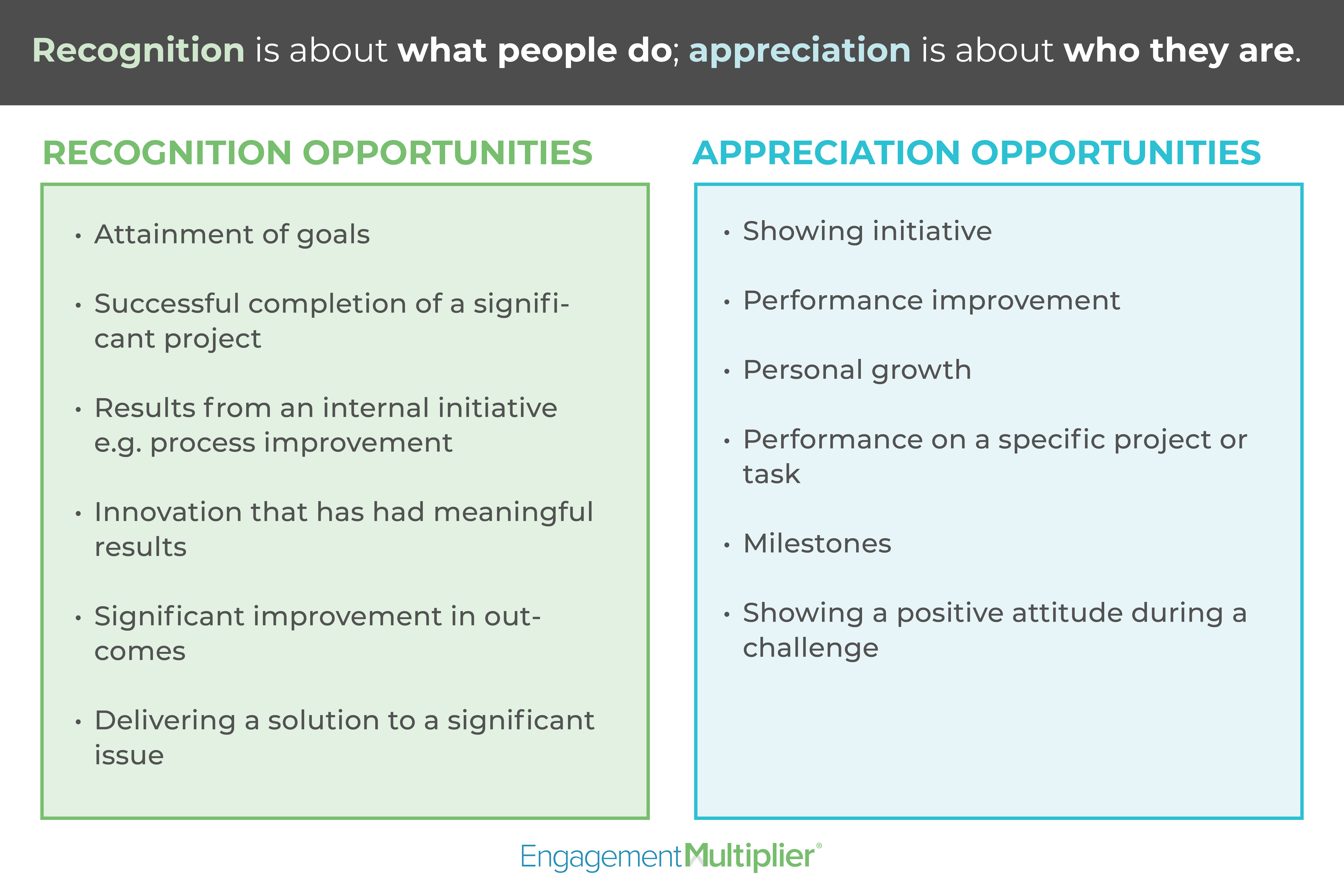The headlines and global employee data agree – a large number of workplaces are not meeting employee needs, so employees are going elsewhere.
People are compelled to look for new jobs for a variety of reasons. However, there’s one leading driver that is entirely controllable and really shouldn’t be on the list, and that is feeling undervalued.
Our own survey data and experience point to this as an area of persistent opportunity for leaders to make simple and meaningful changes that can strengthen culture, boost engagement and performance, and reduce attrition – with little to no cost.
What could achieve all this? Authentic recognition and appreciation of your employees that makes them feel truly valued and respected.
What makes employee recognition and appreciation authentic?
When appreciation and recognition are authentic, people feel seen, valued, and respected. Acts of appreciation and recognition that create that specific outcome are based on interactions, not gestures.
A catered breakfast on “Employee Appreciation Day” is nice, but it doesn’t make employees feel valued – it’s a grand gesture, not a personal interaction.
Arguably, recognising employees’ service anniversaries is similarly ineffective. A form letter signed by the chief executive thanking them for their years of service is nice, but it’s not personal.
The reason why authentic, meaningful, and personal acts of appreciation and recognition are such difference makers is that they strengthen the connection between the employee and their manager, or the employee and the wider organisation.
Feeling valued and respected at work are core tenets of employee engagement. People at every level want to feel their work is meaningful, and they want to feel their time and efforts are well spent and respected by their leaders and colleagues.
Authentic acts of appreciation and recognition go a long way toward ensuring employees feel they are respected and valued.
The difference between employee recognition and appreciation
The words “recognition” and “appreciation” are often used interchangeably, but they have different meanings, and distinguishing between the two is important when it comes to your employees and ensuring they truly feel valued.
“Recognition is about what people do; appreciation is about who they are,” is the concise description offered by the authors of an article on why employees need both recognition and appreciation in Harvard Business Review that is worth reading
Another way to think about it is this: recognition relates to performance or results, and happens after the fact. Appreciation, on the other hand, is interpersonal and should be ongoing.
Both cases represent an opportunity to show gratitude. In recognising an employee’s accomplishments, the organisation is showing gratitude for that person’s actions. Showing appreciation can be thought of as an opportunity to show gratitude for the intangibles a person brings to the organisation, and the value they represent. Below are some examples.

How to provide authentic recognition and appreciation to employees
Recognition, as we noted above, should acknowledge and celebrate an accomplishment or outcome. Additionally, for recognition to be truly meaningful, it needs to come from the top. Peer recognition is nice, but ultimately, one’s colleagues don’t determine promotions or allocate bonuses. Senior leaders carry the most weight in the organisation, and the most meaningful recognition comes from them.
However, as we all know, those same senior leaders are often removed from operational details, especially in larger companies. The challenge of creating the habit of consistent and meaningful recognition requires participation from the organisation’s departmental and team leaders. Here’s a simple framework you can use to make recognition part of your company’s standard operating procedures.
A framework for healthy recognition
- Identify how recognition will be conveyed, such as quarterly meetings, monthly leadership updates, and internal newsletters. These will provide the structure and timing of leadership recognition.
- Determine the sort of accomplishments that merit recognition. Defining the types of outcomes that will be recognised creates another incentive for the desired behaviors, and helps create a degree of scarcity, thus making the recognition noteworthy and special.
- Communicate the programme details and timings to all leaders, along with the expectation that managers, team leads, and department heads will identify relevant employee accomplishments to their respective leaders, who are then charged with sending the information on to senior management. This approach will create more awareness of great performance throughout the organisation and is likely to create more recognition touchpoints with employees.
- Hold managers accountable. Notice who does and doesn’t nominate employees for recognition. Tracking team engagement scores for each manager also creates accountability and encourages improvement.
Show and tell – the keys to meaningful appreciation
While almost everyone enjoys a free lunch or treats at work, the most effective ways to show appreciation are the interactions that build trust and connection between people.
As you’ll see, appreciation doesn’t require a grand gesture. When it comes to meaningful employee appreciation, the little things really do count, such as:
- Being present and listening. Giving people your full attention sends the powerful unspoken message that you appreciate and respect what the other person has to say.
- Being spontaneous and in the moment. There’s no reason to wait to let an employee know they are appreciated. Whether they showed some extra initiative, or simply made you laugh, a word of appreciation is always, well, appreciated.
- Being deliberate, and asking how they are. Another way of showing appreciation authentically is by showing you care. Leaders can do this by regularly checking in with their employees by asking how they’re doing, where they’re feeling stressed, and finding out where people are feeling challenged.
Find more ideas for employee appreciation here, plus learn how it can actually boost profitability.
What happens when employees aren’t recognised and appreciated
Workplaces that don’t encourage or priortise recognising employee contributions or ensuring people feel appreciated are unwittingly laying the groundwork for a variety of negative outcomes, including:
- Feeling disrespected. When leaders recognise people for their contributions, it sends a powerful signal of respect. Feeling respected starts with being recognised, and it’s important: a comprehensive study on why people quit their jobs last year found that “feeling disrespected at work” was one of the top reasons why employees left their employers.
- Feeling ignored. Healthy communications are two-way, requiring a degree of trust between both parties. When a manager shares their appreciation with one of their people or a leader recognises an employee’s accomplishments, trust builds.
- Feeling like they don’t belong. “There’s nothing worse than feeling unseen and unheard in the workplace,” said Annie McKee, author of How to Be Happy at Work in an article for Harvard Business Review about feeling valued at work. “We all have a human need to be appreciated for our efforts, and so when your colleagues don’t notice [your contributions], it makes you feel as though you don’t belong.”
Building a culture of appreciation and recognition is as powerful as it is positive: when people feel valued and respected, their morale and performance improve, and turnover is reduced. The benefits don’t stop there, however. The organisation will more readily see its emerging stars and high-potential employees, building more opportunities for growth and advancement – themselves catalysts for engagement and improved retention. Your managers will make appreciation a habit, reducing another common friction point for employees. Don’t be fooled by the fact that acts of genuine employee recognition and appreciation don’t require a budget, or by their simplicity. Their impact can be remarkable.



